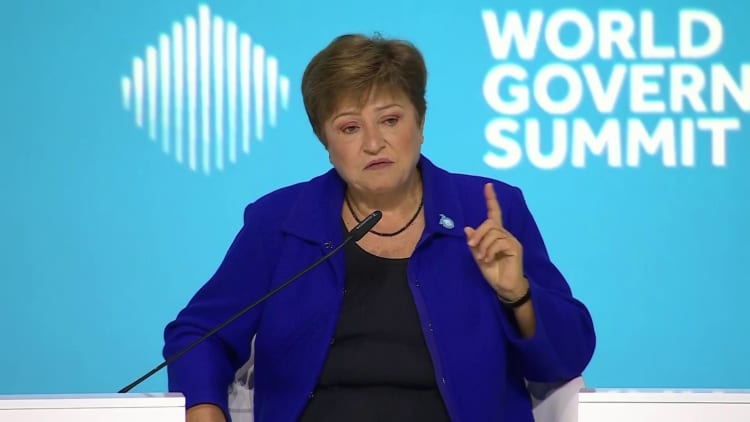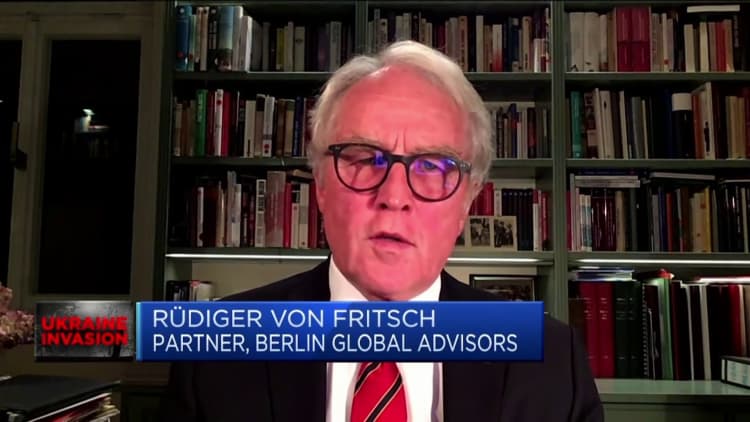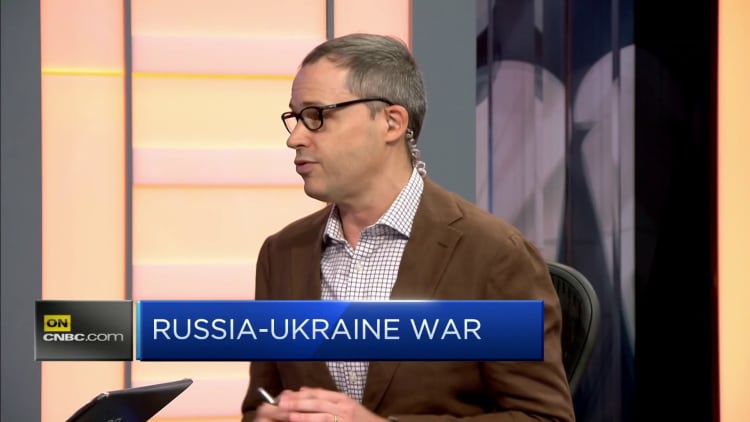Men wearing military uniform walk along Red Square in front of St. Basil’s Cathedral in central Moscow on February 13, 2023.
Alexander Nemenov | Afp | Getty Images
The coming months will be critical in figuring out how Russia’s economy is holding up in the face of a new suite of sanctions, and for how long it can continue pouring money into its military assault on Ukraine.
Russia’s budget deficit hit a record 1.8 trillion Russian rubles ($24.4 billion) in January, with spending growing by 58% from the previous year while revenues fell by more than a third.
Industrial production and retail sales in December fell to their worst year-on-year contractions since the onset of the Covid-19 pandemic in early 2020, with retail sales dropping by 10.5% year-on-year while industrial production shrank by 4.3%, compared to a 1.8% contraction in November.
Russia has yet to report its GDP growth figures for December, which are expected to be incorporated into full-year 2022 data slated for this Friday.
According to the World Bank, the International Monetary Fund and the OECD, Russian GDP dropped by at least 2.2% in a best-case scenario in 2022 and by up to 3.9%, and is widely expected to contract again in 2023.
However, both the Russian finance ministry and the central bank maintain that all of this is within their models.
Several unique circumstances and accounting technicalities go some way to explaining the scale of the January deficit figure, according to Chris Weafer, CEO of Moscow-based Macro Advisory.
The big drop in tax revenue was mostly accounted for by changes in the tax regime that kicked in at the beginning of January, the finance ministry claimed. Companies previously paid taxes twice per month, but now make one consolidated payment on the 28th of each month.

The finance ministry suggested most of the January tax payments had not yet been accounted for by Jan. 31 and will instead feed into the February and March figures.
Weafer also highlighted a change in the Russian oil tax maneuver that came into force in January and is expected to iron out in the coming months, while the nature of Russian public spending allocation means it is heavily concentrated at the end of the year, widening the fiscal deficit.
Christopher Granville, managing director of global political research at TS Lombard, noted two further factors distorting the most recent deficit figures.
Firstly, this was the first print since the sanctioning states’ embargo on Russian crude imports went into force on Dec. 5.
“Before that date, Europe had been loading up with Urals crude, then straight to zero, so the Russian seaborne export trade had to be re-routed overnight,” Granville told CNBC.
“Obviously a lot of preparations for that re-routing had been made (Russia buying up tankers, getting more access to the ‘shadow’ or ‘dark’ fleet etc), but the transition was bound to be bumpy.”

The actual Urals price dived as a result, averaging just $46.8 per barrel during the period from mid-December to mid-January, according to the Russian finance ministry. This was the tax base for much of January’s oil and gas-related federal budget revenues, which also suffered from the fading of a revenue windfall in the fourth quarter from a hike to the natural gas royalty tax.
The finance ministry also flagged massive advance payments for state procurement in January, which totaled five times those of January 2022.
“Although they don’t say what this is, the answer is perfectly obvious: pre-payment to the military industrial complex for weapons production for the war,” Granville said.
How long can the reserves last?
For the month of January as a whole, the average Urals price edged back up to $50 a barrel, and both Granville and Weafer said it would be important to gauge the impact on Urals price and Russian exports as the full impact of the latest round of sanctions becomes clearer.
Sanctioning countries extended bans to bar vessels from carrying Russian-originated petroleum products from Feb. 5, and the International Energy Agency expects Russian exports to plummet as it struggles to find alternative trading partners.
The export price for Russian crude is seen as a central determinant for how quickly Russia’s National Wealth Fund will be drawn down, most notably its key reserve buffer of 310 billion Chinese yuan ($45.5 billion), as of Jan. 1.
Russia has ramped up its sales of Chinese yuan as energy revenues have declined, and plans to sell a further 160.2 billion rubles’ worth of foreign currency between Feb. 7 and Mar. 6, almost three times its FX sales from the previous month.
However, Russia still has plenty in the tank, and Granville said the Kremlin would stop depleting its yuan reserves well before they were fully exhausted, instead resorting to other expedients.

“A flavour of this is the idea floated by MinFin to benchmark oil taxation on Brent rather than Urals (i.e. a material hike in the tax burden on the Russian oil industry, which would then be expected to offset the blow by investing in logistics to narrow the deficit to Brent) or the proposal from First Deputy Prime Minister Andrey Belousov that major companies flush with 2022 profits should make a ‘voluntary contribution’ to the federal budget (mooted scale: Rb200-250bn),” Granville said.
Several reports last year suggested Moscow could invest in another wave of yuan and other “friendly” currency reserves if oil and gas revenues allow. Yet given the current fiscal situation, it may be unable to replenish its FX reserves for some time, according to Agathe Demarais, global forecasting director at the Economist Intelligence Unit.
“Statistics are state secrets these days in Russia especially regarding the reserves of the sovereign wealth funds — it’s very, very hard to know when this is going to happen, but everything that we’re seeing from the fiscal stance is that things are not going very well, and so it is clear that Russia must draw down from its reserves,” she told CNBC.
“Also, it has plans to issue debt, but this can only be done domestically so it’s like a closed circuit — Russian banks buying debt from the Russian state, etcetera etcetera. That’s not exactly the most efficient way to finance itself, and obviously if something falls down then the whole system falls down.”
Early rounds of sanctions following the invasion of Ukraine set out to ostracize Russia from the global financial system and freeze assets held in Western currencies, while barring investment into the country.
Sanctions not about ‘collapse’ of Russian economy
The unique makeup of the Russian economy — in particular the substantial portion of GDP that is generated by state-owned enterprises — is a key reason why Russian domestic life and the war effort appear, at least at face value, to be relatively unaffected by sanctions, according to Weafer.
“What that means is that, in times of difficulty, the state is able to put money into the state sectors, create stability and subsidies and keep those industries and services going,” he said.
“That provides a stabilizing factor for the economy, but equally, of course, in good times or in recovery times, that acts as an anchor.”

In the private sector, Weafer noted, there is far greater volatility, as evidenced by a recent plunge in activity in the Russian auto manufacturing sector.
However, he suggested that the government’s ability to subsidize key industries in the state sector has kept unemployment low, while parallel trading markets through countries such as India and Turkey have meant the lifestyles of Russian citizens have not been substantially impacted as yet.
“I think it’s increasingly dependent on how much money the government has to spend. If it has enough money to spend providing social supports and key industry supports, that situation can last for a very, very long time,” Weafer said.
“On the other hand, if the budget comes under strain and we know that the government can’t borrow money, that they’re going to have to start making cuts and making choices between military expenditure, key industry supports, social supports, and that’s what situation may change, but right now, they have enough money for the military, for key industry supports, for job subsidies and for social programs.”
As such, he suggested that there is little pressure on the Kremlin from the domestic economy or the population to change course in Ukraine for the time being.
Diminished technology access
Demarais, author of a book on the global impact of U.S. sanctions, reiterated that the most significant long-term damage will come from Russia’s receding access to technology and expertise, in turn causing a gradual attrition of its main economic cash cow — the energy sector.
The aim of the sanctions onslaught, she explained, was not a much-touted “collapse of the Russian economy” or regime change, but the slow and gradual attrition of Russia’s ability to wage war in Ukraine from a financial and technological perspective.
“The technology gap, those sectors of the economy that rely on accessing Western technology in particular, or Western expertise, in many areas are definitely going to degrade and the gap between them and the rest of the world is going to widen,” Weafer said.
The Russian government has begun a program of localization and import substitution alongside companies in so-called friendly countries, with a view to eventually creating a new technological infrastructure over the next several years.
“Even the optimists say that’s probably the end of the decade before that can be done, it’s not a quick fix,” Weafer explained.
“I think even government ministers are saying by the time you put everything in place with training and education, facilities etc., it’s a minimum five-year program and it’s probably more like seven or eight years before you can start to deliver engagement, if you get it right.”
A spokesperson for the Russian finance ministry was not immediately available for comment when contacted by CNBC.














